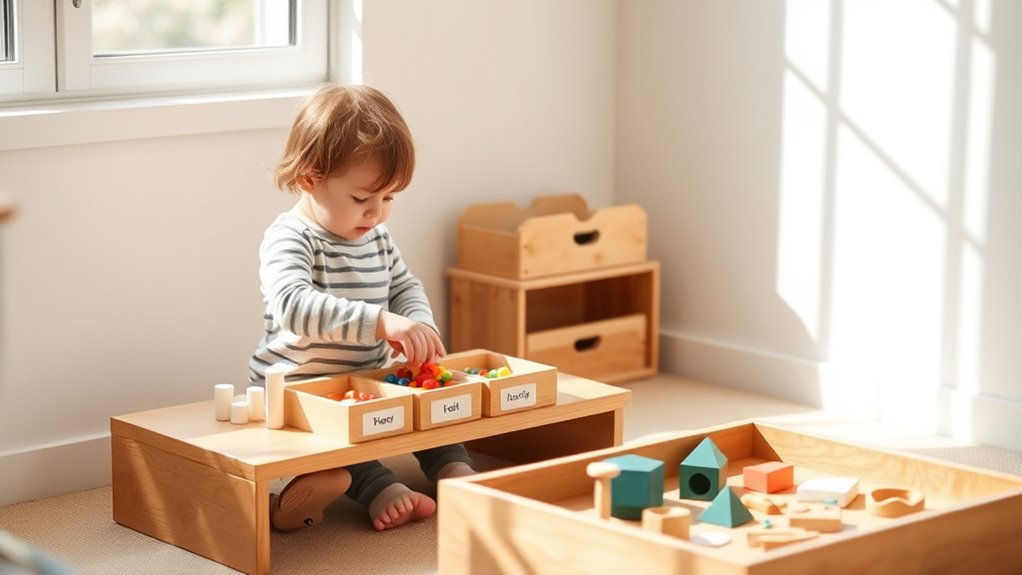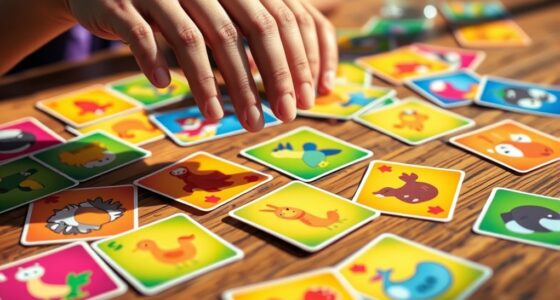To create Montessori-inspired activities at home, design organized spaces that encourage independence and hands-on exploration. Incorporate practical life tasks like pouring, wiping, and using child-sized tools, along with sensory play using everyday materials such as rice or natural textures. Allow your child to choose activities freely and observe their interests, fostering confidence and curiosity. Setting up accessible materials and low shelves helps promote self-directed learning. Keep exploring to find more ways to nurture your child’s natural development.
Key Takeaways
- Create organized, accessible spaces with practical life tools and sensory materials to encourage independent exploration.
- Incorporate everyday activities like pouring, sweeping, and sorting to develop motor skills and confidence.
- Use natural textures and sensory bottles to stimulate tactile awareness and focus.
- Allow children to choose activities freely, fostering autonomy and curiosity.
- Design a stimulating environment that promotes learning through hands-on, real-world experiences.

Creating a Montessori-inspired environment at home can be a rewarding way to support your child’s independence and natural curiosity. When you design spaces that encourage hands-on exploration, you foster a sense of confidence and joy in learning. One of the most effective ways to do this is by integrating sensory play and practical life activities into your daily routine. Sensory play allows your child to engage their senses through touch, sight, sound, smell, and taste, helping them develop important cognitive and motor skills. Practical life activities, on the other hand, teach real-world skills like pouring, sorting, and cleaning, which build fine motor control and promote independence. By thoughtfully combining these elements, you create a rich, stimulating environment that nurtures your child’s natural desire to learn and explore.
Support your child’s independence with sensory play and practical life activities that foster confidence and curiosity.
Start with simple sensory activities that use everyday materials. For example, fill a shallow tray with rice, beans, or pasta, and provide small scoops, spoons, and containers for your child to transfer and sort. These activities are not only fun but also develop hand-eye coordination, concentration, and tactile awareness. You can also set up sensory bottles filled with water, glitter, or small objects, which your child can shake and observe. These activities are easy to prepare, inexpensive, and adaptable to your child’s interests. Incorporate natural textures like fabric swatches, shells, or leaves to further stimulate their senses and connect them to the natural world.
Incorporating practical life activities into your home encourages your child to participate in daily routines. Set up a low shelf with child-sized tools like a broom, a small mop, a hand-held mirror, or a washing station with a small basin and cloths. Show your child how to carry out simple tasks such as wiping a table, pouring water from one container to another, or sorting laundry by color. These activities help your child develop fine motor skills, coordination, patience, and a sense of responsibility. Plus, they foster independence, giving your child a sense of accomplishment as they master these skills.
Creating designated areas for sensory play and practical life tasks makes it easy for your child to access materials independently. Keep everything organized in low, open storage containers, so your child can choose activities freely. Remember, the goal is to let your child engage in activities at their own pace, with minimal adult intervention. As you observe their interests and skills, you can introduce new materials or challenges that match their developmental stage. This approach not only nurtures their independence but also builds a foundation for lifelong learning and curiosity.
Frequently Asked Questions
How Can I Adapt Activities for Different Age Groups?
You can adapt activities for different age groups by using age-appropriate modifications and activity scaling. For younger children, simplify tasks and offer more guidance, while older kids can handle more complex challenges independently. Adjust materials, instructions, and expectations to suit each child’s developmental level, ensuring engagement without frustration. This approach helps nurture their skills at every stage, making activities both fun and beneficial across various ages.
What Safety Precautions Should I Take During Activities?
Your child’s safety is your top priority, so always supervise activities closely. Check that all materials are non-toxic, sturdy, and age-appropriate to prevent accidents. Keep small objects out of reach to avoid choking hazards, and guarantee sharp or breakable items are stored safely away. Make sure the workspace is free of hazards, and teach your child safe practices. By doing so, you create a safe environment where curiosity can flourish without risk.
How Do I Encourage Independence Without Pressure?
To encourage independence without pressure, focus on fostering playful autonomy. Offer your child choices and gently guide them to complete tasks on their own, praising their efforts rather than outcomes. Create a supportive environment where they feel safe to explore and try new things at their own pace. By emphasizing independence building as a fun and natural part of daily life, you help your child develop confidence without feeling overwhelmed or pressured.
Can These Activities Be Done Without Specialized Montessori Materials?
Yes, you can absolutely do these activities without specialized Montessori materials. Use DIY alternatives and material substitutions to adapt activities to what you have at home. For example, replace a Montessori tray with a shallow dish or use everyday objects like buttons or beans for sorting. These simple swaps help foster independence and hands-on learning without the need for specialized equipment, making the activities accessible and fun.
How Much Daily Time Should I Dedicate to These Activities?
On average, children thrive with about 30 minutes to an hour of Montessori-inspired activities daily, making it a manageable part of your daily routine. You should focus on consistent activity scheduling, dedicating specific times for these engaging tasks. This helps your child develop independence and concentration. Remember, quality matters more than quantity, so even short, focused sessions can make a meaningful difference in their growth and learning.
Conclusion
By incorporating these Montessori-inspired activities at home, you’re planting seeds for your child’s independence and curiosity. With patience and consistency, you’ll see them blossom into confident learners. Remember, Rome wasn’t built in a day, so don’t get discouraged if progress feels slow at first. Keep nurturing their love for exploration, and watch as their skills grow—like a well-tended garden, your efforts will pay off in the long run.









